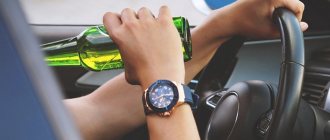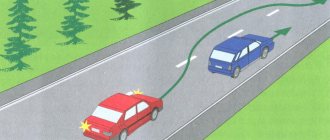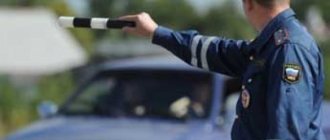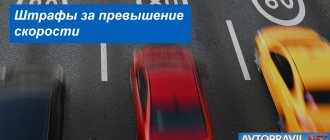What is ppm
This is the name of the indicator; in our case, the degree of alcohol intoxication of a person is established, and it will be calculated based on the amount of alcohol in the blood. If we count purely mathematically, then 1 ppm is equal to 0.45 mg per 1 liter. It is worth considering that alcoholic products remain in the blood for quite a long time, so special devices can accurately determine the presence of alcohol.
Now there are the following ways to determine it:
- the presence of alcohol is determined in the air exhaled by a person;
- The presence of alcohol in the blood is determined by taking a blood test from a vein in medical institutions.
Actions of a traffic police officer in a situation where the driver is drunk
If a driver is stopped and a traffic police officer considers it necessary to conduct a test for alcohol intoxication, you need to behave with restraint and calm. To refuse an examination means to be subject to even greater suspicion. You need to make sure that the breathalyzer is certified and in working order. A traffic police officer has no right to interfere with or hide information.
After recording the readings, if the driver’s permissible alcohol limit is exceeded, the inspector draws up a report. Any objections that the driver has must be reflected in it. After reading the information specified in the protocol, the driver needs to sign it.
The examination process must be carried out in the presence of witnesses (at least 2) or with video recording. Otherwise, the violation gives the driver the opportunity to refer in court to procedural errors, as a result of which the punishment is unlawful.
Driving while drunk will result in a fine, after which the State Traffic Inspectorate will send the case to court. If, based on the results of the meeting, a decision is made to deprive of rights, they will have to be surrendered voluntarily within 3 days after the decision comes into force. But you can file an appeal within 10 days.
Testing for alcohol intoxication by a traffic police officer is his legal right. But if for some reason a person does not want to undergo it on the spot, then the traffic police officer will write out a referral to a medical institution, where he must report immediately.
Permissible alcohol limit while driving in ppm
Of course, the inspector will not check you for alcohol if there are no certain signs of intoxication and the person is in normal condition. The law requires you to undergo an examination if you have the following symptoms:
- slurred and incoherent speech of the driver;
- unnaturally reddened skin on a person’s face;
- unsteady gait and unnatural posture;
- characteristic smell of alcoholic drinks;
- unstable psychological and emotional state.
All of these symptoms usually appear after drinking alcoholic beverages. If there are characteristic signs, the inspector must draw up an inspection report and send the driver for a medical check.
On-site measurements of ppm are made with a breathalyzer in the exhaled air. Such measurements must take place in the presence of witnesses and the result of the inspection is reflected in the report. In the document, the inspector describes all identified signs of intoxication, information about all persons present during the measurement (full name, address, contact phone number), the amount of intoxication in ppm, as well as the date and time of detection of the violation of the law.
In the event that the driver refuses to undergo the examination or the device shows zero values, he is sent to a medical facility to re-measure the amount of alcohol in the person’s blood, but using a blood test. If you refuse the study, you will definitely be deprived of your right to drive a car for driving while drunk.
In 2021, the permissible standard has not changed compared to last year; it is equal to 0.16 ppm. Therefore, if the device detects a larger number, an administrative violation report will be drawn up against the driver.
It is worth remembering that there are a lot of products, the consumption of which can show a small amount of alcohol on a traffic inspector’s device:
- nonalcoholic beer;
- chocolate candies;
- kefir and other sourdough products;
- kvass;
- sandwich made from black bread and sausage, etc.
Each of these products contains a certain amount of alcohol, which is excreted only after some time. For several years (from 2010 to 2013), this led not only to financial sanctions, but also to the deprivation of the rights of many inexperienced drivers. After many trials, it was decided to abolish the zero ppm and establish a new standard - 0.16 ppm.
In 2021, a certain amendment to the law was adopted; if the driver is unable to exhale into a breathalyzer, for example, in the case of severe intoxication or unconsciousness, then in this case it is possible to take a blood test of the person and determine the degree of his intoxication. If the indicator is higher than 0.35 ppm, then, of course, the offender will not be able to avoid punishment. There is no need to specifically use both methods.
What is the penalty for violation?
In other countries, violators are treated with loyalty, but most punish them quite harshly for excessive alcohol consumption. In Japan, for example, if a driver is drunk, not only him, but also the passengers in the car are fined. And in China, exceeding the established standards for the content of alcohol vapor in the exhaled air is considered a criminal offense, punishable by imprisonment. If a Chinese driver commits a fatal accident, the court has the right to sentence him to death.
Legislation of the Russian Federation
Russian legislation does not deal so harshly with alcohol lovers. But after the new law came into force, it became expensive to drink alcohol before a trip - drunkenness while driving faces a fine of 30 thousand rubles. Inadequate condition also leads to deprivation of rights for one and a half to two years (Article 12.8 and Article 12.27 Part 3 of the Code of Administrative Offenses); in this case, the car will wait for the owner at the impound area. If a similar violation is committed again, the drunk driver will pay 50 thousand and lose the right to drive a car for three long years.
Punishment for exceeding the permissible alcohol limit while driving
The law established fairly severe penalties for such violations, because a drunk driver is one of the main causes of car accidents, including deaths. That's why legislators are trying to tighten the penalties for driving while intoxicated.
Let's look at what the offender faces:
- upon initial detection, a fine of 30 thousand rubles may be imposed. and deprivation of the right to drive a car for 1.5-2 years;
- if a citizen repeatedly drives a car while drunk, the amount of the sanction increases to 50 thousand rubles, and the driving license will be taken away for 3 years;
- if a driver who has already been fined and deprived of his license is caught drunk driving a car, then he will be arrested for 10-15 days, these days he will have to sit behind bars;
- if the driver refuses to undergo a medical examination, then the measure will be applied to him, as in the first case.
Note!
If a car owner has transferred control of his vehicle to a person who is intoxicated, he faces liability equal to that if he himself was drunk driving: a 30 thousand fine and deprivation of rights from 1.5 to 2 years. The driver will receive the same punishment.
Many deputies are initiating the imposition of a more severe penalty and demand that administrative liability be replaced with criminal liability. Therefore, you should not break the established rules.
The traffic police offers a 50% discount if the fine is paid on time, but this opportunity does not apply in all cases; this privilege cannot be used if:
- the driver refused to undergo medical examination. examination;
- a person was caught driving a car while intoxicated.
Therefore, in these cases it will not be possible to reduce the fine.
What is this new law?
In fact, only one article of the Code with fines is changing, which provides for deprivation of rights plus an impressive fine for driving while intoxicated - both narcotic and alcoholic.
But the changes affected only the determination of the fact of intoxication and only alcoholic intoxication - if previously the concentration in exhaled air was determined, now, in addition to this, it is possible to determine it in the blood. Please note that the method for determining drunkenness does not change, namely, it is supplemented by the ability to determine more than 0.3 grams of alcohol per liter in the blood. Comparative table of changes in the definition of intoxication in blood and air
| Was | It became |
| 1. Driving a vehicle by a driver who is intoxicated, if such actions do not constitute a criminal offense, entails an administrative fine in the amount of 30,000 rubles with deprivation of the right to drive vehicles for a period of 1.5 to 2 years. Note. Administrative liability provided for by this article and part 3 of article 12.27 of this Code occurs in the event of an established fact of consumption of substances that cause alcohol intoxication, which is determined by the presence of absolute ethyl alcohol in a concentration exceeding the possible total measurement error, namely 0.16 milligrams per liter of exhaled breath. air, or in the case of the presence of narcotic drugs or psychotropic substances in the human body. | 1. Driving a vehicle by a driver who is intoxicated, if such actions do not constitute a criminal offense, entails an administrative fine in the amount of 30,000 rubles with deprivation of the right to drive vehicles for a period of 1.5 to 2 years. Note. Administrative liability provided for by this article and part 3 of article 12.27 of this Code occurs in the event of an established fact of consumption of substances that cause alcohol intoxication, which is determined by the presence of absolute ethyl alcohol in a concentration exceeding the possible total measurement error, namely 0.16 milligrams per liter of exhaled breath. air, or the presence of absolute ethyl alcohol in a concentration of 0.3 or more grams per liter of blood, or in the case of the presence of narcotic drugs or psychotropic substances in the human body. |
Punishment under the Criminal Code for exceeding the permissible alcohol limit while driving
This violation falls under the category of administrative cases, but in some cases criminal liability arises. Therefore, intoxication will be an aggravating circumstance in the following cases:
- An accident involving victims with serious injuries, when a drunk driver was the culprit of the accident. In this case, the penalty is imprisonment for up to 4 years;
- in case of a fatal accident, a prison sentence of no more than 7 years is imposed;
- if there are 2 deaths, you can end up behind bars for up to 9 years.
Note!
In case of criminal punishment, in addition to imprisonment, a person will be prohibited from driving for 3 years. Drivers often get off with suspended sentences.
Recommendations for drivers to avoid losing their driver's license
If you drank alcohol and for some reason had to get behind the wheel, but you don’t want trouble on the road, then you should follow the rules as much as possible:
- the best option is not to drive, but if there is no other choice, then it will be better if as much time as possible passes between drinking alcohol and driving;
- do not take medications, especially those containing ethyl alcohol;
- do not consume kvass and fermented milk products, as they can increase the amount of alcohol in the blood;
- the use of chewing gum may be regarded by the inspector as an attempt to hide traces of alcohol;
- Do not enter into conflict with the inspector under any circumstances, this will only aggravate the situation.
Summary
The driver will not be able to deceive the modern devices of traffic police inspectors. Therefore, you should not exhale a little or, conversely, inhale air; in any case, the breathalyzer gives true readings. If a deviation from acceptable indicators is detected, a protocol on an administrative offense will be drawn up against a citizen.
Not only traffic safety on the road, but also human lives depend on the condition of the driver behind the wheel. Therefore, the best option, if you have drunk alcohol, is to ask a sober person to take you home or use public transport so as not to endanger yourself and others.
ATTENTION!
Due to recent changes in legislation, the information in this article may be out of date!
Our lawyer will advise you free of charge - write in the form below.
Changes to traffic rules that came into force in 2021
Until 2021, drinking and driving was regarded exclusively as an administrative violation. This issue was regulated by the Code of Administrative Offenses of the Russian Federation. For the first contact while intoxicated with representatives of the traffic police, the driver had to pay a fine of thirty thousand rubles, and was also deprived of his license for a period of 18 to 24 months.
In case of a collision for the second time while driving while intoxicated, the fine increased to fifty thousand, and the license was deprived for three years. In a word, all these measures taken did not have particularly unpleasant consequences for the driver, despite the fact that driving while drunk is an immediate threat to the health and life of innocent citizens.
The new bill, which came into force on July 1, 2018, has put everything in its place
- First contact with the law while driving while intoxicated. For this, a fine of three hundred thousand rubles is also imposed, and the person is deprived of his driver’s license for a period of 18 to 24 months. This more stringent measure should prevent the repetition of the incident, as well as remove the irresponsible driver from Russian roads for a long time.
- Second contact while intoxicated. If the situation repeats, then more stringent measures must be taken. Now this can be either a fine from 200 thousand to 300 thousand rubles or imprisonment for up to two years. In other words, repeated driving while intoxicated threatens the driver with criminal liability with all the ensuing consequences. In addition, he will also be disqualified from driving for 18 to 24 months.










